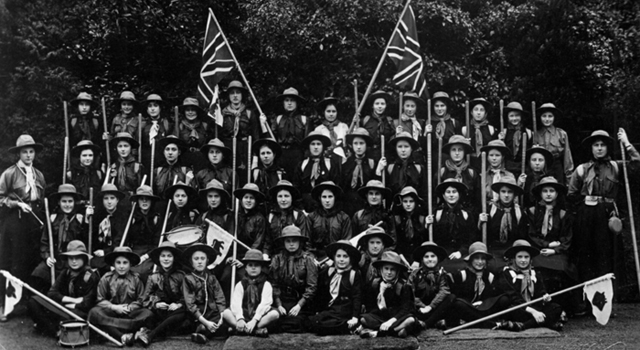Articles

One Comment
By Voices
On 09, Mar 2015 | One Comment | In Gender | By Voices
Girl Guides: Gender and Childhood on the Home Front
Professor Maggie Andrews, University of Worcester
The Girl Guides Association, having been formed in 1910, was still a fledging organisation when the war broke out. The activities that Guides became involved in over the four years of war demonstrate both that life on the Home Front was a gender specific experience and the range of contributions that children made to the war effort.
![Abbey Girl Scouts, 1911-1916 [Courtesy of Worcestershire Girl Guides]](http://www.voicesofwarandpeace.org/wp-content/uploads/2015/03/abbey-girl-scouts-1911-16.jpg) In August 1914 a letter from Miss Agnes Baden Powell, then President of the Guides encouraged them to work for badges that would be useful; especially First Aid, cooking, nursing, knitting and gardening. Alternatively, advice for girls at home included: ‘Go and cheer up families who have had to part with a father or son’. Whilst young lads in Scouts and other boy’s organisations were perhaps seen as preparing for military service, Guides had a more supportive wartime role keeping up morale. Agnes Baden Powell suggested: ‘Many of us will not be called into the fighting line but let us put forth all our strength to help others to be resolute and hopeful, confident that good will come.’
In August 1914 a letter from Miss Agnes Baden Powell, then President of the Guides encouraged them to work for badges that would be useful; especially First Aid, cooking, nursing, knitting and gardening. Alternatively, advice for girls at home included: ‘Go and cheer up families who have had to part with a father or son’. Whilst young lads in Scouts and other boy’s organisations were perhaps seen as preparing for military service, Guides had a more supportive wartime role keeping up morale. Agnes Baden Powell suggested: ‘Many of us will not be called into the fighting line but let us put forth all our strength to help others to be resolute and hopeful, confident that good will come.’
Scouts and Guides were one of many sources of voluntary child labour for the war effort engaged for example in fruit picking and growing vegetables. Along with many schools they assisted with the national egg collections for wounded soldiers. In 1916 they collected a number of herbs for medicines including foxglove for digitalis, broom and hemlock. Scouts and Guides were also encouraged to run errands, take part in war saving and collect waste paper and magazines but Guides were also specifically encouraged to undertake much more gendered tasks.
Girl Guides’ wartime roles were predominantly domestic or about caring for the sick or young; they were encouraged to take charge of hospital linen, make ration bags for soldiers and help in soup kitchens and day nurseries. Like their mothers they were expected to knit and roll bandages and when the Guide’s War Service Badge was introduced it was awarded for 100 hours of service in hospitals, war offices, public services and the making 15 items of clothing: 4 pr. Socks and 4 pairs of mittens, 2 shirts, pyjamas, 1 child’s garment, 1 women’s garment, 1 belt and a bed jacket for a serviceman.
There is scope for further research on the role of regional guild troops; Heather Talbot has identified many of the troops which emerged in the parts of Worcestershire by the end of WWI including Stourbridge, Redditch and Dudley. Some of the first troops were linked to private schools and colleges such Malvern Girls’ College and there was also a troop at the YMCA in Worcester. Lady Baden Powell who took over as Chief Commissioner in 1917 visited the county on a number of occasions, speaking at a Conference in Malvern. Many troops of girls had been keen to actively participate in the scouting movement; like the one at Abbey School where the 1st troop formed in 1911 and followed the principles of Baden Powell’s Scouting for Boys. However, they were re-registered as a Girl Guide Company in 1916. They had been reluctant to give up being Scouts having enjoyed their drums, bugles and scout poles, but did so after Lady Baden-Powell made a personal appeal to them; accepting the gender demarcation of the movement and of wartime.
With thanks to the research of Margot Grosset and Heather Talbot, and the exhibition ‘World War One in the Vale’ in October 2014.
Submit a Comment



Comments